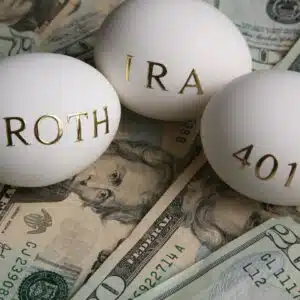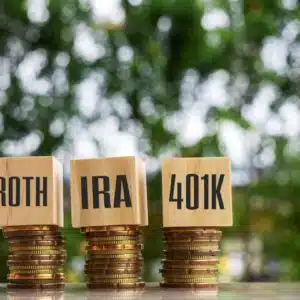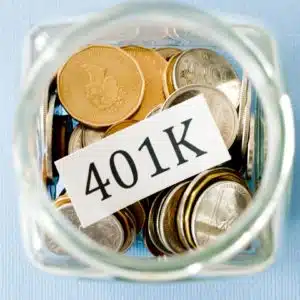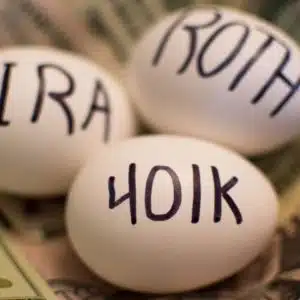One of the very best investment vehicles to prepare for retirement is a Roth IRA. It gives you an opportunity to provide tax-free income once you retire.
But a Roth IRA itself is not an investment.
That’s why it’s important to know the best investments for a Roth IRA in 2025.
The table below summarizes six of the top investments to hold in a Roth IRA. You can skim for the basics, then read the more detailed descriptions that follow.
| INVESTMENT | BEST FOR | MINIMUM INVESTMENT | RISK LEVEL | FEES |
|---|---|---|---|---|
| Stocks | Long-Term Growth | None | Moderate to High | $0 |
| Bonds/Fixed Income | Safety of Principal/Risk Reduction | $100 to $1000 | None to Moderate | Nominal, Based on Broker |
| Exchange Traded Funds (ETFs) | Passive Diversification of Stocks and Bonds | The Share Price of One ETF | Moderate to High | $0 |
| Mutual Funds | Active Diversification of Stocks and Bonds | At Least $1,000 | Moderate to High | 0% to 3% |
| Cryptocurrency | Alternate Investment/Long-Term Growth | Varies by Platform | High | Varies by Exchange or Broker |
| Real Estate Crowdfunding | Investing in Real Estate Deals or Funds | As Low as $10 | Moderate to High | 1% to 3% |
Our Picks for 6 Best Investments for Roth IRA
Table of Contents
- Our Picks for 6 Best Investments for Roth IRA
- 1. Stocks: Best for Long-Term Growth
- 2. Bonds & Fixed Income: Best for Safety of Principal and Risk Reduction
- 3. ETFs: Best for Passive Diversification of Stocks and Bonds
- 4. Mutual Funds: Best for Active Diversification of Stocks and Bonds
- 5. Cryptocurrency: Best for Alternate Investment/Long-Term Growth
- 6. Real Estate Crowdfunding: Best for Investing in Real Estate Deals or Funds
- Roth IRA Investment Guide
- Final Thoughts – Summary of the Best Roth IRA Investments
Normally, when we provide “best for” guides for any financial service, we also offer a ranking of which we believe to be the best of the group. But in this case, we’re covering broad investment categories. Each is either necessary in building a successful Roth IRA or at least highly desirable.
For that reason, we’re not going to provide a rank for our picks of the best investments for a Roth IRA. But we will provide what each investment class is best for within your portfolio.
- Stocks: Long-Term Growth
- Bonds/Fixed Income: Safety of Principal/Risk Reduction
- ETFs: Passive Diversification of Stocks and Bonds
- Mutual Funds: Active Diversification of Stocks and Bonds
- Cryptocurrency: Alternate Investment/Long-Term Growth
- Real Estate Crowdfunding: Investing in Real Estate Deals or Funds
1. Stocks: Best for Long-Term Growth
- Minimum Investment: None
- Risk Level: Moderate to High
- Fees: 0
For long-term growth, stocks are the most basic asset to hold in a Roth IRA. That’s because a Roth IRA is a retirement plan usually held for decades. Bank assets yielding less than 1% will not produce a big retirement nest egg.
But stocks, which average about 10% per year, can turn regular contributions into a seven-figure portfolio.
You’ll need to learn how to begin stock investing, which will require knowledge of stocks, trading, platforms, and other terms. It’s also important to choose a brokerage account if you want to invest in individual stocks.
A brokerage account is an investment account for your free-to-trade individual securities, like stocks. The best online stockbrokers not only enable you to trade stocks online but also offer commission-free trades. Examples include E*TRADE and TD Ameritrade.
If you’re an advanced investor, you could also look into the best investment apps. They offer streamlined, high-speed trading but with little support or knowledge required.
At the opposite end of the spectrum, take a look at the best robo-advisors if you want to invest in stocks but aren’t comfortable choosing or managing your own investments.
2. Bonds & Fixed Income: Best for Safety of Principal and Risk Reduction
- Minimum Investment: $100 to $1,000
- Risk Level: None to Moderate
- Fees: Nominal, Based on Broker
The word “bonds” covers a lot of territory. There’s no single bond but rather a mix of different interest-bearing securities.
Unlike a stock, which represents the share of ownership in a business entity, a bond is a debt security and, therefore, has limited growth potential. It’s issued for a fixed amount, with a fixed rate of interest, and fully repaid at the end of the term.
In theory, at least, bonds maintain a constant value. This is why they offer the safety of principal and risk reduction to an overall portfolio.
For example, a portfolio comprising 80% stocks and 20% bonds presents less volatility than one made up entirely of stocks.
The safest type of bonds are the best short-term investments for your money. These include money market accounts, certificates of deposit, and short-term bonds and bond funds.
They should never dominate your portfolio, but a relatively small allocation will help minimize losses during a down market in stocks.
If you’re looking for higher-yielding bonds or bond equivalents, consider the longer-term investments. Generally speaking, the longer the term of the bond, the higher the interest rate it will pay.
As an alternative, consider investing part of your Roth IRA in an alternative investment platform, like YieldStreet.
YieldStreet allows you to invest in asset-based investments that generate higher yields, such as small business loans and real estate. These investments are secured by physical assets and have lower risk than stocks or bonds.
But overall, you can expect higher returns than you’ll get from most income investments.
3. ETFs: Best for Passive Diversification of Stocks and Bonds
- Minimum Investment: The Share Price of One ETF
- Risk Level: Moderate to High
- Fees: 0
If you don’t like the idea of choosing individual stocks and bonds, you can invest in exchange-traded funds (ETFs). These are mostly passively managed investment funds but hold hundreds or even thousands of securities by investing in an underlying index.
ETFs have become highly specialized over the years due to the large number of potential indexes a fund can be tied to.
One of the most common is the S&P 500 index. That fund has averaged about 10% per year, going all the way back to the 1920s. But there are other indexes that track specific industries, like technology in healthcare, or even countries like the European Union, China, or Japan.
ETFs are considered “passive” precisely because they are tied to an index fund. The fund manager does not need to choose individual stocks or bonds. That results in very low portfolio turnover and very low fees.
Investing in ETFs is one of the simplest ways to invest, which is why it has become so popular in recent years. You only need to choose which indexes you want to invest in and then select the ETFs that represent those sectors.
ETF vs. mutual fund is another important consideration since many new investors confuse the two. While an ETF is typically tied to an underlying index, mutual funds are actively managed.
Both charge an expense ratio, which is essentially a management fee measured as a percent of your investment in the fund.
One of our top choices for purchasing ETFs (and stocks) is the popular robo-advisor M1 Finance (read our review here). You can build your own ETF portfolio or use one of their “custom pies” built by professional investors.
4. Mutual Funds: Best for Active Diversification of Stocks and Bonds
- Minimum Investment: $3,000 and Up, but Some Allow Low Monthly Contributions
- Risk Level: Moderate to High
- Fees: 0 to 3%
Mutual funds are closely related to ETFs, and some are even similarly index-based. But what makes mutual funds stand out most from ETFs is the fact that they are commonly actively managed.
Instead of being tied to an underlying index, the fund manager attempts to outperform the market by buying and selling individual securities at hopefully opportune times.
Much like ETFs, mutual funds can be invested in stocks or bonds. Each fund usually chooses a different type of security to invest in. For example, a fund may invest in tech stocks, energy companies, emerging growth companies, or large-capitalization stocks.
In each case, the fund will attempt to outperform the market by choosing the best-performing stocks in the sector.
Because mutual funds are actively traded, they do involve fees. The most significant are what are known as load fees, sales charges imposed either when you buy or sell a position in a mutual fund, and sometimes both.
The fee can range between 1% and 3% of the amount invested, though an increasing number of mutual funds no longer charge these fees.
Even though mutual funds attempt to outperform the market, they’re not necessarily a way how to make money fast. Many of them, even most, underperform the general market.
If you’re a beginner, you’ll need to learn the ways to invest small amounts of money. Check out our guides on investing with various small amounts of capital:
5. Cryptocurrency: Best for Alternate Investment/Long-Term Growth
- Minimum Investment: Varies by Platform
- Risk Level: High
- Fees: Varies by Exchange or Broker
Cryptocurrency isn’t quite “Roth IRA account ready” yet. But it’s getting harder to ignore, especially when planning for retirement.
Crypto investing is relatively new, having begun only in 2009. The returns crypto can be spectacularly high-yield, but it does require a high level of risk tolerance. It’s amazing how quickly this asset class has grown and matured in just a few years.
That said, crypto must be regarded as one of the highest-risk investment options. It is a relatively new asset class and notorious for wild swings in price — both higher and lower.
There are currently thousands of different cryptos available, which makes the field even riskier. But without a doubt, the star performer in the space is Bitcoin. If you want to begin investing in crypto, start by learning how to invest in Bitcoin. It’s by far the most common type of crypto available.
But at the moment, at least, there is a limitation with investing in crypto for retirement purposes. That’s because there are very few institutions that enable you to open a retirement account, including a Roth IRA, that allows you to invest in crypto.
That will give you two basic choices if you want to invest in crypto for retirement. You can either select from the best crypto exchanges to open a non-retirement account for you to hold crypto or go with one of the very few platforms that actually offer crypto within a retirement account.
At the moment, TradeStation is one of the very few mainstream brokerage firms offering Roth IRA accounts with crypto investing.
SDIRAs
Another choice is to open a self-directed IRA (SDIRA) with a trustee, like a Bitcoin IRA. It offers a Roth IRA account that specializes in crypto and also allows you to hold gold bullion within the plan.
An SDIRA is a special type of IRA account that allows you to hold nontraditional assets, like crypto, precious metals, and even real estate. You’ll also need an SDIRA to hold most real estate crowdfunding investments.
It’s designed primarily for more sophisticated investors since it is a higher-risk account with higher account fees. But if you want a dedicated crypto retirement, an SDIRA such as a Bitcoin IRA may be an option.
6. Real Estate Crowdfunding: Best for Investing in Real Estate Deals or Funds
- Minimum Investment: As Low as $10
- Risk Level: Moderate to High
- Fees: 1% to 3%
Most everyone is familiar with the benefits of real estate as a long-term investment. It’s an excellent diversification away from stocks because it often moves in a different direction. There are times when stocks are declining and real estate is rising in value.
For practical purposes, there’s no way to hold brick-and-mortar real estate in a retirement plan. Fortunately, there are alternatives. One that’s becoming increasingly popular is real estate crowdfunding.
Unlike real estate investment trusts, where you invest in a portfolio of properties, real estate crowdfunding enables you to choose the specific types of property you want to invest in.
You can invest in shares of an individual property, own a property outright, or invest in a non-publicly traded real estate investment trust that invests in very specific property types.
One of the big advantages of real estate crowdfunding platforms is that they give you an opportunity to invest in commercial real estate.
That’s one of the most lucrative real estate investments available. It includes office buildings, retail spaces, large apartment complexes, and other projects.
Real estate crowdfunding is becoming very user-friendly. With just a few dollars, you can invest in an online real estate crowdfunding platform. There, you can choose the investments you want to invest in.
Fundrise
One of the top real estate crowdfunding platforms is accredited investor status, which is a common requirement of many real estate crowdfunding platforms.
You can get more information on the platform by reading our review of Fundrise. And if you’re looking for real-life investment results, read Jeff’s report, My 4-Year Fundrise Returns – Is Fundrise Worth it?
If real estate crowdfunding has a disadvantage, it’s that the investments usually cannot be held in a standard IRA or Roth IRA account.
However, you can use a self-directed IRA (SDIRA) account for most real estate crowdfunding investments, which can also be available for Roth IRAs (see the next section below).
Roth IRA Investment Guide
What Is a Roth IRA?
A Roth IRA is a plan for retirement savings, one of many permitted by the IRS, that allows you to build tax-deferred — and ultimately tax-free — savings for your retirement.
You can make annual contributions to a Roth IRA, even if you are covered by a retirement plan through your employer.
But as you’ll read in the FAQ section below (under “How much can you put in a Roth IRA?”), there are income limits you cannot exceed. Otherwise, you won’t be able to make a contribution.
The trade-off with a Roth IRA is that contributions are not tax-deductible. However, investment earnings on those contributions will accumulate on a tax-deferred basis.
If the funds are held until at least age 59½, and you have been in a Roth plan for at least five years, you will be able to make withdrawals tax-free.
This can be an important tax diversification strategy that will ensure at least some of your earnings in retirement will escape taxes. That will be an especially important strategy if you anticipate a high income in retirement.
Roth IRA vs Traditional IRA
A Roth IRA and a traditional IRA are very similar. They have identical contribution limits, and each enables your account to grow on a tax-deferred basis. You can also open a self-directed account for either a Roth or traditional IRA and manage your own investments.
Both types of individual retirement accounts also allow you to manage your risk and financial goals through periodic rebalancing.
But that’s largely where the similarities end. Here’s the difference between Roth IRAs vs traditional IRAs:
While traditional IRAs offer tax-deductible contributions during the accumulation phase, Roth IRA contributions are not tax-deductible. While traditional IRA withdrawals are taxed as ordinary income in retirement, Roth IRA distributions can be taken tax-free.
There’s another important distinction between the Roth IRA and the traditional IRA. Like virtually every other type of retirement plan, traditional IRAs are subject to required minimum distributions (RMDs).
These require that you begin taking distributions at age 73, using a formula based on your age and expected remaining life expectancy. The percentage of your plan that must be distributed each year increases.
However, the Roth IRA is not subject to RMDs. That means you can literally plan for the rest of your life. For that reason, a Roth IRA is a solid investment decision to avoid outliving your money.
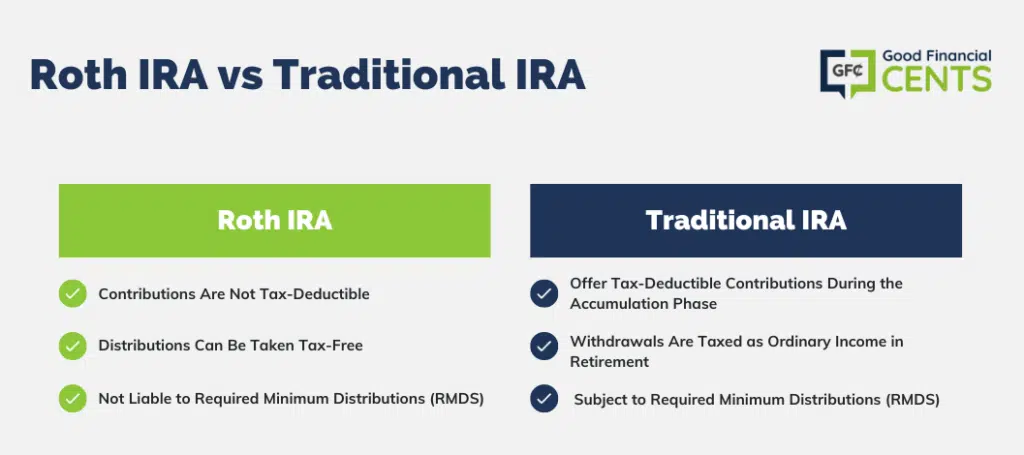
Where to Start a Roth IRA
You’ll want to choose from the best Roth IRAs, and fortunately, there are plenty of options here. But which you choose will depend on how you want to invest.
We’ve already discussed using investment brokers like E*TRADE and TD Ameritrade if you want to invest in individual securities, like stocks and bonds.
But if you prefer investing through funds and you’re not comfortable choosing those funds, you can go the traditional route and use a financial planner, or you can open your Roth IRA with a robo-advisor.
Robo-advisors are online, automated investment services that will create and manage your portfolio for a very low annual fee. That means all you need to do is fund your account on a regular basis, and the robo-advisor will handle all the details for you.
One of the most popular robo-advisors is Betterment. You can open an account with no money at all and then fund it to begin investing. They charge a very low annual advisory fee of 0.25%. That means you can have a $10,000 account managed for just $25 per year.
If you’re a beginner, you might want to try Stash. Not only does it provide you with the portfolio template you’ll need, but it helps you to accumulate the funds needed to build your Roth IRA account.
If you like the idea of choosing your own stocks and bonds but don’t want to manage them, investigate M1 Finance. It’s one of the most innovative robo-advisors there is.
You create your own portfolios, referred to as “pies,” and fill each with up to 100 individual securities or ETFs. M1 Finance will then manage each pie with no annual fee.
Tracking Multiple Roth IRAs
If you have multiple IRA accounts, including a Roth IRA, you may want to look into Personal Capital. It’s not a robo-advisor, but more of a low-cost financial advisor.
If you have a portfolio totaling at least $100,000, Personal Capital can provide comprehensive investment management that balances the holdings you have in different accounts to create a comprehensive investment strategy.
Finally, don’t limit yourself to just a Roth IRA. As mentioned earlier, it should be part of a larger retirement strategy with many types of investments.
Choose from one of the best retirement plans, especially if you’re self-employed. Some will allow you to invest as much as $7,500 per year for your retirement. At least some of that can be in a Roth IRA.
Main Benefits of a Roth IRA
The main benefits of a Roth IRA are as follows:
- Tax-free withdrawals of income in retirement.
- Tax-free withdrawals of contribution amounts before reaching age 59½.
- The Roth IRA is not subject to required minimum distributions.
- You’re free to choose the investment trustee and the investments you will hold in your plan.
- Capital gains aren’t taxed, but to access them tax-free, you’ll need to use a qualified distribution
Main Disadvantages of a Roth IRA
The main disadvantages of a Roth IRA are as follows:
- Contributions to a Roth IRA are not tax-deductible.
- Contribution amounts are relatively low compared with other plans.
- Because contributions are not tax-deductible, they may be subject to seizure by creditors in certain states. (If you have credit issues that might result in seizure, investigate the best credit repair services to get the situation remedied.)
- There are income limits beyond which you cannot make a Roth IRA contribution.
| PROS OF ROTH IRA | CONS OF ROTH IRA |
|---|---|
| Tax-Free Withdrawals at Retirement | Contributions Not Tax-Deductible |
| Access to Contributions | Contribution Amounts Lower Than 401(k)s |
| RMDs Not Required | Contributions May Be Subject to Seizure by Creditors |
| Power to Choose Own Custodian | Income Limits for Roth IRA Participation |
| No Tax on Capital Gains |
Final Thoughts – Summary of the Best Roth IRA Investments
Once again, below is our list of the five best Roth IRA investments for 2025:
- Stocks: Long-Term Growth
- Bonds/Fixed Income: Safety of Principal/Risk Reduction
- ETFs: Passive Diversification of Stocks and Bonds
- Mutual Funds: Active Diversification of Stocks and Bonds
- Cryptocurrency: Alternate Investment/Long-Term Growth
- Real Estate Crowdfunding: Investing in Real Estate Deals or Funds
Stocks and bonds/fixed income should make up the vast majority of your Roth IRA portfolio. And of course, you can hold these more conveniently through either mutual funds or especially ETFs.
But if you’re excited by all that’s been happening in the crypto space, you may also want to add a small position in cryptocurrency.






